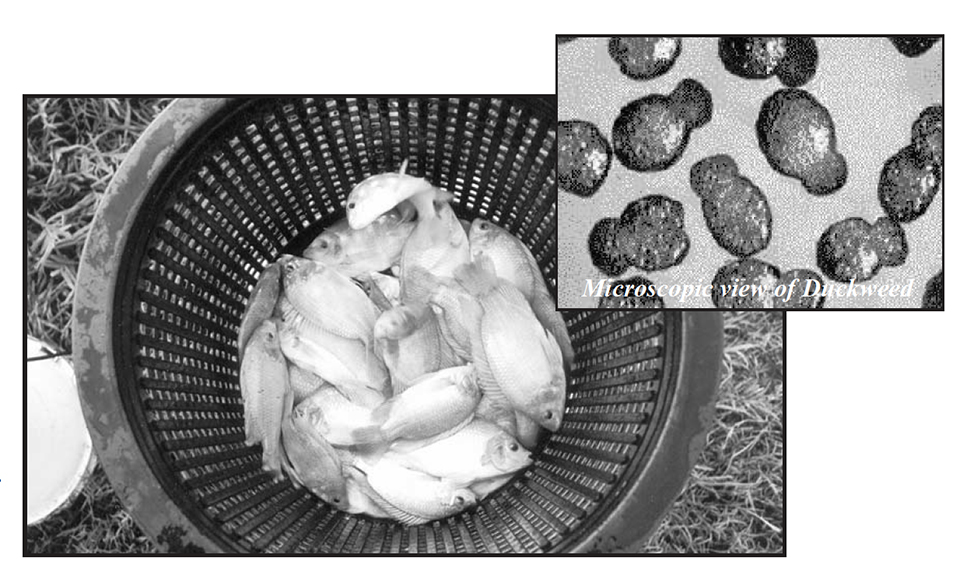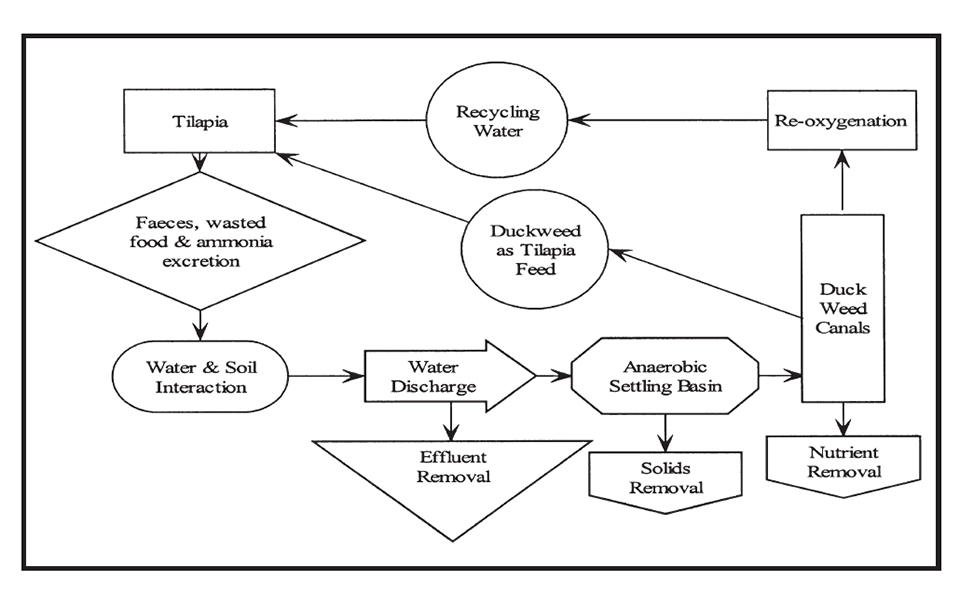Facing the economic reality of sustainable commercial aquaculture

What is the number one problem facing the rapid advancement of sustainable aquaculture? For many commercial operations, the answer is simple – bad economics. The hard reality is that, all too often, the bottom line gets in the way of the development of innovative solutions for sustainable aquaculture. But what if there were a system that could actually result in huge operational cost reductions from year one and greater profits on the bottom line? Sound too good to be true? Well then, perhaps you have never heard of duckweed.
What is duckweed?
Duckweed is the common name for a family of small aquatic herbs known as Lemnaceae that grows in fresh water. They have the unique distinction of being the smallest flowering plants on earth. These plants are also unique in that they do not have any stem or leaf structures. The plant is simply a fleshy ovoid or flattened structure that may or may not bear simple roots. These highly successful plants represent the ultimate in reduction for a vascular plant. Duckweed is ubiquitous to most temperate and tropical regions of the world, making it readily available to most farmers. They are typically found floating in thick mats of homogeneous populations in quiet streams or ponds containing high levels of organic matter. Another amazing feature of these plants is that they can double their mass in less than two days under ideal conditions of nutrient availability, sunlight and temperature. To put this into perspective, a small patch of duckweed could theoretically cover the entire surface of a 0.5-hectare pond in less than 50 days!
What is the value of duckweed to sustainable tilapia culture?
Perhaps the most important feature of these little aquatic plants to freshwater fish culturists is that they are extremely efficient absorbers of ammonia, nitrate, phosphorous, potassium, magnesium, calcium, sodium, chlorine, boron and iron. In a properly designed water recirculation and purification system, duckweed can remove as much as 99 percent of the nutrients and dissolved solids in wastewater. Unquestionably, the potential contribution of duckweed to the advancement of sustainable freshwater aquaculture is enormous, yet surprisingly very little research has been done in this area.
The integrated tilapia & duckweed farming system
In the integrated tilapia and duckweed recirculating system (Fig. 1), the fish and the waters of the tilapia grow-out ponds provide the nutrients upon which the duckweed will thrive. In turn, the duckweed removes unwanted nutrients and waste products from the system, converting the nutrients into plant biomass. This plant biomass, in turn, becomes a high protein food for the tilapias. While all this is going on, water within the integrated system is conserved and purified. The entire system is a natural and sustainable approach to aquaculture.

Basic design criteria of the integrated duckweed water recirculation system
Water from the tilapia farm typically enters the first of a series of two sedimentation lagoons. The total detention time of the recirculating water within the sedimentation lagoon will have a direct relationship to the sedimentation rate. After sedimentation, water is directed into a series of long narrow channels that are fully stocked with duckweed. As the water slowly works its way through this quiescent filtration zone, it becomes purified. Since the water exiting the duckweed zone will be very low in oxygen, there must be careful consideration to the issue of re-oxygenation. The total area devoted to the sedimentation lagoons and the duckweed must be at least 20 percent of the total grow-out area. Increasing the percentage of area devoted to water treatment will only serve to improve the overall effectiveness of the nutrient removal process.
Basic culture requirements for duckweed
Duckweed culture requires fairly intensive management for optimum production. Daily attention and frequent harvesting are needed to ensure that the crop is productive, healthy and controlled. The optimal standing crop density of duckweed is between 400 to 800 grams per square meter. Colonies can be effectively managed using floating PVC structures, giving the farmer a dense yet manageable crop. Daily harvesting of the incremental growth is a standard practice.
Co-cropping with another waterloving plant provides an added dimension to this highly managed and sustainable system. The chosen plant is planted along the water’s edge to serve as wind and direct sunlight barriers for the floating duckweed plots. The shade offered by the waterline plants aids in keeping water temperatures in a favorable range for the duckweed. Either taro, which produces a tuber known as “yucca,” or banana plants are ideal crops for many tropical locales. Importantly, these plants can provide additional revenues to the operation and further maximize the utilization of the farm’s valuable water resources.
The potential value of duckweed as a supplemental tilapia feed
One of the most important benefits of the duckweed produced in the integrated system is that it can be used as a readily accepted supplemental feed for the tilapias. Grown under ideal conditions, duckweed can have protein levels as high as 35 to 45 percent. Duckweed protein has high concentrations of the essential amino acids lysine and methionine and is also high in trace minerals and pigments. Generally speaking, the overall nutrient characteristics are quite similar to those of soybeans. Fresh duckweed can be fed directly to the tilapias or it can be dried and incorporated into a custom pelleted feed. As shown in Table 1, the cost savings associated with utilization of duckweed as an alternative food source can be very significant.
Frese, duckweed, Table 1
| Assumed full production level (metric tons) | 1,000 |
|---|
Assumed full production level (metric tons) | 1,000 |
|---|---|
| Assumed feed conversion ratio (FCR) | 1.7:1 |
| Total amount of pelleted floating feed required (kg’s) | 1,700,000 |
| Cost of pelleted floating feed ($/kg) | $0.60 |
| Total cost of pelleted floating feed (kg’s) | $1,020,000 |
| Gross savings at 10% substitution level | $102,000 |
| Gross savings at 25% substitution level | $255,000 |
| Gross savings at 50% substitution level | $510,000 |
| Gross savings at 75% substitution level | $765,000 |
While many of the proposed solutions for sustainability in the aquaculture industry are conveniently being criticized for being too costly, here is a system that has the potential to pay for itself through significant and sustainable reductions in operational expenses. This is the beauty and promise of the integrated tilapia and duckweed culture system.
For more information, please visit AquaSol’s web site at www.fishfarming.com.
(Editor’s Note: This article was originally published in the April 2000 print edition of the Global Aquaculture Advocate.)
Now that you've finished reading the article ...
… we hope you’ll consider supporting our mission to document the evolution of the global aquaculture industry and share our vast network of contributors’ expansive knowledge every week.
By becoming a Global Seafood Alliance member, you’re ensuring that all of the pre-competitive work we do through member benefits, resources and events can continue. Individual membership costs just $50 a year. GSA individual and corporate members receive complimentary access to a series of GOAL virtual events beginning in April. Join now.
Not a GSA member? Join us.
Author
Tagged With
Related Posts

Responsibility
Evaporation affected by sunlight, temperature, wind
Evaporation of water from ponds is influenced by solar radiation, air and water temperature, and wind velocity. Control of aquatic plants can yield some reduction.

Responsibility
A helping hand to lend: UK aquaculture seeks to broaden its horizons
Aquaculture is an essential contributor to the world food security challenge, and every stakeholder has a role to play in the sector’s evolution, delegates were told at the recent Aquaculture’s Global Outlook: Embracing Internationality seminar in Edinburgh, Scotland.

Health & Welfare
A look at aquaculture in Guyana
With its large quantities of water and little industry to pollute it, Guyana has the potential to become a greater player in global aquaculture.

Health & Welfare
A look at tilapia aquaculture in Ghana
Aquaculture in Ghana has overcome its historic fits and starts and is helping to narrow the gap between domestic seafood production and consumption. Production is based on Nile tilapia.


